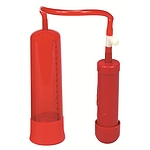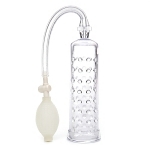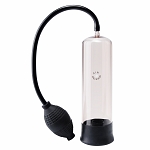Penis Pumps
A penis pump (Vacuum Constriction Device / VCD) is a cylinder that is fitted over the penis, with a manual or motorized pump to create suction.
The device consists of an acrylic tube and a pumping mechanism, which can be a squeeze ball, a hand grip, a plunger, or an electric device. As the user pumps air out of the tube, the resulting vacuum increases blood flow into his erectile tissue. He then slides a “constriction ring” over the base of his penis to maintain the erection when he removes the tube.
Some men have physical condition that can not be cured from erectile dysfunction mediations and supplements such as Viagra and Endurnz and must seek a more extreme physical treatment.
A vacuum erection may not always feel like the real thing. Various sources describe them as “spongy and semi-flaccid,” purplish in color, and sometimes cold or numb. The results are often short lived. Some men report no more than 5 minutes before the effects end. But clinical studies still find high rates of satisfaction among those who receive the vacuum treatment for ED.
As vacuum increases, the difference between the inner blood pressure and the pump pressure increases as well; excessive pressure causes vascular damage rather than a harder penis. If the pump is not used correctly, however, there can be loss of sensation, loss of penile skin, and even permanent damage to tissue surrounding the penis.
How Well Do Penis Pumps Work?
Studies suggest that about 50%-80% of men are satisfied with the results of penis pumps. As with any other method of treatment for erectile dysfunction (ED), satisfaction rates may decrease with time.
 |
 |
 |
| Nasswalk Penis Pump | Doc Johnson Penis Pump | Pipe Dream Penis Pump |
Penis pumps have been around for decades. Prototypes were developed in the early 20th Century. In 1983, Vacu-Tech designed the first Hi-Tech enlarging system using space age materials and technology. Leading companies today are: California Exotic, Nasswalk, Pipe Dream, Doc Johnson, and Pos-T-Vac Pumps
Penis pumps, usually described in this context as vacuum pumps, have use in conventional alleviation of impotence. The pump itself is essentially as described above, although often made to higher standards of quality with a much higher price, and arrangements for distribution by suppliers of medical equipment. The purpose is not to cure the condition, but to attain an erection by mechanical and hydrodynamical means even if there is nerve and vascular damage preventing a full natural erection; once the penis is erect, a compression ring is slid on to maintain the erection which will otherwise subside immediately.
 A flexible compression ring (or sometimes more than one), commonly called cock rings when used recreationally, must be used. It is fitted on the open end of the cylinder, then an erection is created by pumping. Then the ring is pushed by hand onto the base of the erect penis before releasing the vacuum. This restricts blood flow out of the now erect penis, enabling the erection to be held even in the presence of problems of the vascular or nervous system which would otherwise lead to immediate loss of erection. In the best circumstances erections can be maintained for a considerable time, but manufacturers’ literature recommends that, for safety, rings should be removed after no more than 30 minutes. Very prolonged use (hours) will cause permanent harm.
A flexible compression ring (or sometimes more than one), commonly called cock rings when used recreationally, must be used. It is fitted on the open end of the cylinder, then an erection is created by pumping. Then the ring is pushed by hand onto the base of the erect penis before releasing the vacuum. This restricts blood flow out of the now erect penis, enabling the erection to be held even in the presence of problems of the vascular or nervous system which would otherwise lead to immediate loss of erection. In the best circumstances erections can be maintained for a considerable time, but manufacturers’ literature recommends that, for safety, rings should be removed after no more than 30 minutes. Very prolonged use (hours) will cause permanent harm.
A personal lubricant of a type not harmful to the ring material is used, primarily to make a good seal at the base of the pump to prevent air leakage, in the same way that vacuum grease is used with a laboratory vacuum pump. It also makes it easier to slide the ring off the cylinder, and later to remove the ring.
Pumping must be done very carefully to avoid serious injury: over-enthusiastic pumping can burst blood vessels and form blisters. In some cases the testicles can be unexpectedly pulled into the cylinder, causing discomfort, pain, and possibly injury. It is also believed that the rim of the cylinder can cut into the skin and over time cause damage to the ligaments surrounding the penis. Impatiently pumping without reading explanatory material can produce too much suction (any pressure lower than 10 torr/1,333 Pa) and cause permanent and irreparable injury. Attempts at using vacuum cleaner units for this purpose have resulted in extremely severe injuries because the suction is far too powerful.
Pumps used with rings are virtually always effective, as they operate by a simple mechanical process, in cases of ED, even when pharmaceutical methods fail. They may nonetheless be found unsatisfactory due to the inconvenience and similar factors.
The effectiveness of penis pumps for permanent penis enlargement was examined by Kazem, Hosseini and Alizadeh. They studied 37 men with penis length less than 10 cm and found no significant change in penile length after using pumps for six months, although the follow-up have found 30% satisfaction with the method. The conclusion of the paper stated that vacuum treatment of the penis is not an effective method for penile elongation, but provides psychological satisfaction for some men.
A 31-patient study conducted by the Department of Urology at St Peter’s Hospitals and the Institute of Urology in London investigating the usefulness of pumps to correct the penile curvature associated with Peyronie’s disease found that “There was a clinically and statistically significant improvement in penile length, angle of curvature and pain after 12 weeks of using the vacuum pump“. In this study, subjects with Peyronie’s undertook two ten-minute pumping sessions per day for twelve weeks. The additional penis length was an unexpected side effect and not an intended aim of the study, but large enough to be statistically significant.
Penis pumps may be funded by Medicare, where a patient’s erectile dysfunction is deemed to necessitate this. Since 2001, Medicare has spent $240 million on penis pumps for elderly men. In 2001, Medicare spent $11 million on these penis pumps. By 2010, they were spending $47 million per year.


 A new minimally invasive procedure using tiny plastic spheres is showing promise to become the new standard in BPH treatment
A new minimally invasive procedure using tiny plastic spheres is showing promise to become the new standard in BPH treatment
Leave a comment